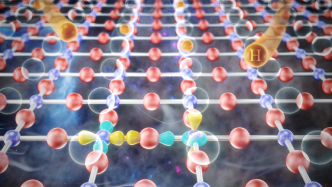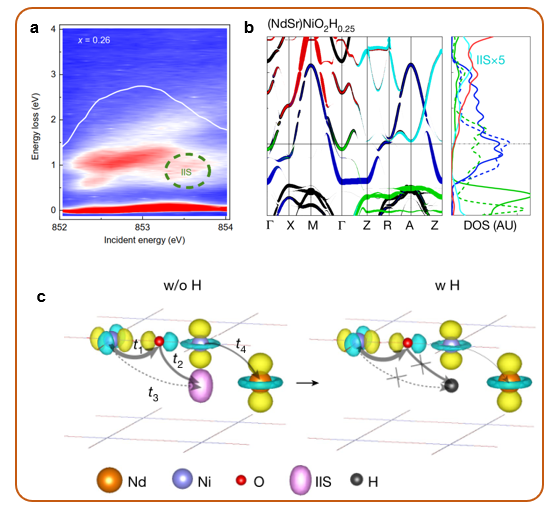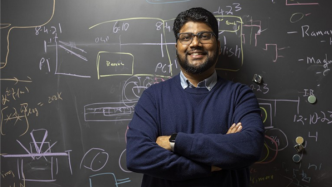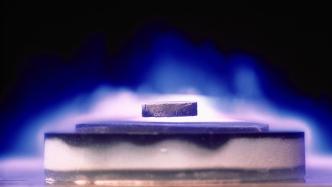
According to the University of Electronic Science and Technology in Chengdu, Sichuan, on March 2, the team of Professor Qiao Liang from the School of Physics of the school made a major breakthrough in the research field of new superconducting materials, opening up a new idea for the development of the field of nickel-based superconductivity. The research results were published online in the international academic journal Nature.

The team of Professor Qiao Liang from the School of Physics, University of Electronic Science and Technology of China has made a breakthrough in the field of superconducting new materials, and related papers have been published online in the international academic journal Nature.
For the first time, researchers have discovered that the key element for superconductivity in nickel-based superconductors -- infinite-layer nickel oxide superconductors -- is hydrogen (H). The hydrogen element is like an "invisible hand", which plays a role in changing the electronic structure of the Fermi surface during the preparation process of the infinite layer structure nickel-based oxide epitaxial single crystal thin film.
In addition, the researchers also experimentally observed exotic electronic states (interstitial s orbitals) for the first time.

For the first time, researchers have discovered that hydrogen is the key element for superconductivity in nickel-based superconductors.
On March 2, Qiao Liang, one of the corresponding authors of the aforementioned paper and a professor of the School of Physics at the University of Electronic Science and Technology of China, told The Paper that this is the second paper in the journal Nature in the field of nickel-based superconductivity. The last such paper was 4 years ago, in 2019, when Stanford University in the United States discovered nickel-based superconducting materials, and made this material from scratch. But the development of this field has always been difficult, because it is not known why it can superconduct, and why similar samples made by other research groups do not superconduct. At present, only a few research groups in the world can make nickel-based superconducting samples.
Qiao Liang told The Paper that "this is a basic research", which is quite revolutionary. For the first time, the existence of hydrogen was discovered through experiments, and it was found that hydrogen is very important to nickel-based superconductivity, and explained the effect of hydrogen on superconductivity from the experimental and principle levels. At the same time, I would like to tell you that many previous related papers and theories are not completely accurate, because the existence and function of hydrogen were not considered at all before, so this research result can deepen our understanding of superconductivity from the source.
Qiao Liang said that although we have now discovered the reason why this material was not easy to prepare, which can effectively promote the research in the field of nickel-based superconductivity, how to control the incorporation of hydrogen very conveniently, very simply, effectively, and accurately remains to be seen. There are many problems to solve.
Qiao Liang explained that their research found that the hydrogen in the nickel-based material "kills" the interstitial s orbital on the one hand, and superconductivity appears ; but when there is more hydrogen, the doping effect comes out, "too much."
Since a large number of research on superconducting materials must be carried out in an ultra-low temperature environment, Qiao Liang expressed to Pengpai Technology that he hopes to have the opportunity to carry out relevant research in the natural ultra-low temperature environment of space and test the application of related materials.
For the "infinite layer" in the infinite layer nickel oxide superconductor, Qiao Liang said that through chemical methods, the oxygen atoms at specific structural positions in this material are taken away, and the "infinite layer" can be understood as a two-dimensional planar structure material , only the X and Y axes.

(a) IIS orbital excitation observed by RIXS experiment; (b) IIS orbital calculated by DFT theory; (c) Schematic diagram of hybridization of IIS orbital with Ni3dx2-y2, Ni3dz2, Nd5dz2, O2p and other orbitals.
According to reports, the research on nickel-based superconductivity is the frontier field of condensed matter physics, which plays an important role in revealing the intrinsic physical mechanism of high-temperature superconductivity and the development of a new generation of superconductivity technology.
Since the research group of Professor Hwang from Stanford University in the United States first discovered superconductivity in a nickel oxide epitaxial film (Nd0.8Sr0.2NiO2) based on an infinite layer structure in 2019, the development of the field of nickel-based superconductivity has not been smooth. Although some new phenomena of nickel-based superconductivity have been reported one after another, the mystery of the origin of superconductivity, the difficulty of sample preparation, and the poor reproducibility among different research groups have become two major problems that plague the field, restricting the development of nickel-based superconductivity. development in the field.
Generally speaking, the laws of physics exist objectively. When the problem of "unreproducible performance" frequently occurs in material samples prepared by different scientists' research groups, the first intuition is that there may be unknown "hidden variables" inside the material, which "quietly" changes the prepared material. physical properties.
Through systematic and in-depth research, Qiao Liang's team found a large amount of hydrogen in nickel-based superconducting epitaxial films by using time-of-flight secondary ion mass spectrometry (ToF-SIMS) with extremely high element sensitivity.
Does hydrogen element affect the superconductivity of infinite layer nickel oxide? Through the research on the transport properties of extremely low temperature and high magnetic field, the team found that under the condition of constant Sr content, the continuous phase transition of " weak insulation → superconductivity → weak insulation " can be realized by adjusting the content of H element, which shows that H element is indeed It plays a key role in the emergence of superconductivity. Further, these results can explain why the growth of nickel-based superconducting epitaxial thin films is so difficult. Only a few research groups in the world can successfully prepare zero-resistance superconducting samples, and the sample repeatability is poor. The main reason is that previous experiments by different research groups may not have taken into account the influence of the presence of H on superconductivity, and did not accurately control the H content of the sample.
In order to further understand how the H element affects the superconductivity of nickel-based materials and reveal its microscopic mechanism, the team studied the nickel-based superconductor charge through synchrotron radiation-based resonant X-ray inelastic scattering (RIXS) technology and electronic structure calculations. For the electronic structure near the rice surface, the strange electronic state, that is, the touring interstitial s orbital (IIS) , was observed experimentally for the first time, and combined with theory, it was found that the hybridization of H elements and IIS orbitals is beneficial to reduce Ni3d-Nd5d and Ni3d-IIS The orbital coupling promotes the emergence of a superconducting state.
This shows that the hydrogen element is like an "invisible hand", which quietly plays a role in changing the electronic structure of the Fermi surface during the preparation process of the infinite layer structure nickel-based oxide epitaxial single crystal thin film, and plays a role in the superconductivity of nickel-based materials. Plays a key role in the process of sexuality. The research results have corrected our understanding of the electronic structure of this type of material, provided key information for understanding the physical origin of nickel-based superconductivity, and provided accurate information for a deeper understanding of the physical and material properties of nickel-based superconductivity in the future. physical model.

As the simplest element in nature and the first element in the periodic table, hydrogen atom has the smallest atomic radius and atomic mass, so the interaction between hydrogen and conventional detection media (photons, electrons, etc.) is weak and the scattering cross section is small, making it difficult to was detected.
In the history of science, hydrogen has created several famous "suspense incidents". One of the classic examples is the story of GaN-based blue light-emitting diodes (LEDs). Back in the 1980s, the main technical limitation in manufacturing blue LEDs was the lack of stable and efficient P-type GaN. Several years after experimental scientists achieved P-type conduction and blue LEDs in Mg-doped GaN through technical means, theoretical scientists unraveled this mystery: On the one hand, hydrogen has It helps to stabilize the lattice structure of P-type doped GaN; on the other hand, the intervention of hydrogen ions "secretly" compensates the hole doping effect induced by MgGa defects, resulting in P-type doped GaN being non-conductive. Discovering the "hidden" hydrogen element and further overcoming the problems caused by the hydrogen element have become the key to the successful industrialization of blue LEDs, and have also brought us into today's colorful LED era.
The School of Physics, University of Electronic Science and Technology of China is the first unit to complete the above-mentioned latest published paper. Qiao Liang from the University of Electronic Science and Technology of China, Zhou Kejin from the UK’s Diamond Light Source, and Huang Bing from the Beijing Computing Science Research Center are the co-corresponding authors of the paper. The research also received strong support from research groups from Chengdu University, Peking University and the University of New South Wales in Australia.


